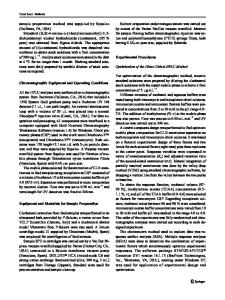Development and Validation of Sample Preparation and an HPLC Analytical Method for Dissolution Testing in Fed-State Simu
- PDF / 1,445,419 Bytes
- 13 Pages / 595.276 x 790.866 pts Page_size
- 21 Downloads / 305 Views
Research Article Theme: Team Science and Education for Pharmaceuticals: the NIPTE Model Guest Editors: Ajaz S. Hussain, Kenneth Morris, and Vadim J. Gurvich
Development and Validation of Sample Preparation and an HPLC Analytical Method for Dissolution Testing in Fed-State Simulated Gastric Fluid—Illustrating Its Application for Ibuprofen and Ketoconazole Immediate Release Tablets Harsh S. Shah,1 Rusha Sardhara,1 Kajal Nahar,1 Ting Xu,2 Poonam Delvadia,3 Akhtar Siddiqui,3 Zongming Gao,4 Arzu Selen,3 and Kenneth Morris1,5,6
Received 8 February 2020; accepted 29 April 2020 Abstract. Dissolution testing and solubility determinations in different biorelevant media have
gained considerable interest in the pharmaceutical industry from early-stage development of new products to forecasting bioequivalence. Among all biorelevant fluids, the preparation of fed-state simulated gastric fluid (FeSSGF) and handling of samples from dissolution/solubility testing in FeSSGF is considered to be relatively challenging. Challenges include maintaining the stability of FeSSGF medium upon sampling, filtration, and mitigating analytical interference of excipients and milk components. To overcome these challenges, standard and uniform working practices are required that are not only helpful in preparation of stable FeSSGF but also serve as a harmonizing guide for the collection of dissolution/solubility samples and their subsequent processing (i.e., handling and assay). The optimization of sample preparation methodology is crucial to reduce method-related variance by ensuring specificity, robustness, and reproducibility with acceptable recovery of the analytes. The sample preparation methodology includes a combination of techniques including filtration, solvent treatment, and centrifugation to remove the interfering media-related components and excipients from the analyte. The analytes of interest were chromatographically separated from the interfering analytes to quantify the drug concentration using the new high-performance liquid chromatography methods with ultraviolet detection. The methods developed allow rapid sample preparation, acceptable specificity, reproducible recoveries (greater than 95% of label claim), and quantification of study drugs (ibuprofen and ketoconazole). The sample preparation technique and method considerations provided here for ibuprofen and ketoconazole can serve as a starting point for solubility and dissolution testing of other small molecules in FeSSGF. KEY WORDS: FeSSGF; milk; biorelevant; dissolution; ibuprofen; ketoconazole.
Guest Editors: Ajaz S. Hussain, Kenneth Morris, and Vadim J. Gurvich
INTRODUCTION
1
One of the challenges in drug product development is the availability and selection of appropriate dissolution methods for predicting in vivo behavior of a drug product. Study test model drugs ibuprofen (a weak acid) and ketoconazole (a weak base) have been in the market since the early 1980s. There are many publications on their solubility, in vitro dissolution and absorption characteristics, approache
Data Loading...











